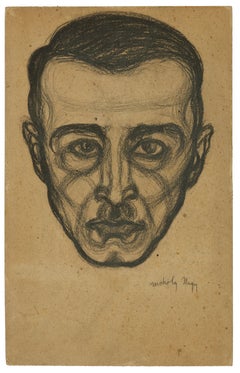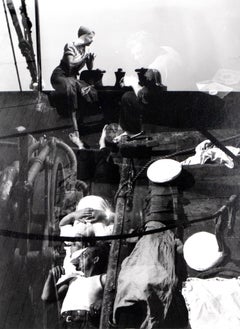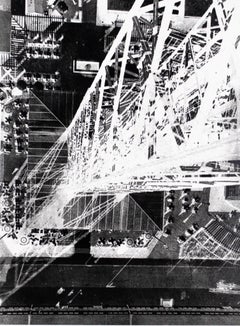László Moholy-Nagy Art
Hungarian, 1895-1946
László Moholy-Nagy was a Hungarian painter and photographer as well as a professor in the Bauhaus school. He was influenced by constructivism and a strong advocate of the integration of technology and industry into the arts. He also wrote books and articles advocating a utopian type of high modernism.
to
1
1
1
Overall Height
to
Overall Width
to
1
1
1
1
1
1
1
1
11
6,938
3,292
2,514
1,213
1
1
1
1
Artist: László Moholy-Nagy
Portrait of a man, an expressionist drawing by László Moholy-Nagy
By László Moholy-Nagy
Located in PARIS, FR
This recently rediscovered expressionist drawing by László Moholy-Nagy is part of a small group of drawings made by the artist early in his career, in Vienna and Berlin. The use of interlaced curves, typical of the artist's technique, gives this hieratic portrait a magnetic radiance, while the absence of any connection with the rest of the body evokes a profane Holy Face.
1. From Hungary to Chicago, the ardent life of László Moholy-Nagy
Moholy-Nagy was born in Borsod, now known as Bácsborsód in Southern Hungary, in July 1895. He studied law in Budapest in 1913, when he was drafted into the Austro-Hungarian army to serve as an artillery officer on the Italian and Russian fronts. While serving at artillery observation posts, Moholy-Nagy was able to execute numerous drawings, recording his traumatic war experience, on the reverse of military-issued postcards which he could easily carry with him. In 1917, he was seriously wounded and hospitalized. The following year (around 1918 at the age of 23), he abandoned his plans to become a lawyer in favour of a career as an artist, with the encouragement of his friend, the art critic Iván Hevesy.
The drawings executed in those early years reveal Moholy-Nagy's powerful Expressionist lines. In his autobiography of 1944, Abstract of an Artist, Moholy-Nagy explained his early figurative style, writing that contemporary art in those days was too chaotic and that and all the '-isms' were incomprehensible and puzzling to him.
He was, however, experimenting with Dadaist compositions already in 1919 and then moved to Vienna and later to Berlin, where he would soon make his first works in his Constructivist style of the early 1920s.
In Berlin he met photograph and writer Lucia Schultz who became his wife the next year. In 1922 he met Walter Gropius. During a vacation on the Rhome with Lucia, she introduced him to making photograms on light-sensitized paper. Walter Gropius invited him to teach at the Bauhaus in Weimar in 1923 where he replaced Paul Klee as Head of the Metal Workshop. The Bauhaus became known for the versatility of its artists and Moholy-Nagy was no exception: throughout his career, he became proficient in the fiels of photography, typography, sculpture, painting, printmaking, film-making and industrial design.
In 1928 Moholy-Nagy left the Bauhaus and established his own design studio in Berlin. He separated from his first wide Lucia in 1929. In 1931 he met actress and scriptwriter Sibylle Pietzsch. They married in 1932 and has two daughters, Hattula (born 1933) and Claudia. After the Nazis came to power in Germany in 1933, he was no longer allowed to work there. He moved his family to London in 1935. In 1937, on the recommendation of Walter Gropius, Moholy-Nagy moved to Chicago to become the director of the New Bauhaus, but the school closed in 1938. Moholy-Nagy resumed doing commercial design work, which he continued for the rest of his life.
In 1939 Moholy-Nagy opened the School of Design in Chicago, which became in 1944 the Institute of Design, becoming part of the Illinois Institute of Technology in 1949. Diagnosed with leukemia in 1945, Moholy-Nagy died of the disease in Chicago in 1946.
2. Description of the artwork
This drawing presents us with a frontal representation of a man in his thirties, whose penetrating gaze seems to stare at us. The face is highly symmetrical and is modelled by curved black lines. The very high forehead and the slightly dilated left pupil reinforce the very expressive character of the face.
Like the Holy Face which appeared on the cloth stretched out to wipe Christ's face by Saint Veronica, only the model's face is represented on the cardboard piece. The curved lines that define the face, hollowing out the temples, the eyelids, the cheeks and the area around the mouth, create a kind of magnetic radiation around a median point located between the eyebrows.
In some respects, this face may evoke one of the most famous representations of the Holy Face: the extraordinary engraving by Claude Mellan...
Category
1910s Expressionist László Moholy-Nagy Art
Materials
Wax Crayon, Cardboard
Related Items
Sit woman pastel drawing
By Rafael Duran Benet
Located in Barcelona, Barcelona
Rafael Duran Benet (1931-2015) - Sit woman - Pastel
Drawing measurements 62x42 cm.
Frame measurements 82x62 cm.
Rafael Duran Benet (Terrassa, 1931 - Barcelona, 2015) is a Catalan painter...
Category
1970s Post-Impressionist László Moholy-Nagy Art
Materials
Pastel
Set of 9 Figure Illustrations Egyptian Classical Characters Listed American
Located in Cirencester, Gloucestershire
Set of x 9 figures
original watercolour painting on artist paper
signed by Marjorie Schiele (1913-2008) *see notes below
piece of paper is 14 x 10 inches
In good condition
provenance...
Category
Early 20th Century American Impressionist László Moholy-Nagy Art
Materials
Watercolor
Rococo Portait, French Rococo, Marie Baudouin, Daughter of Francois Boucher
By François Boucher
Located in Greven, DE
Portrait of the daughter of Francois Boucher, Marie-Emilie Baudouin, holding a basket of flowers. Pastel on Parchment. The work is related to an oval portrait painting...
Category
18th Century Rococo László Moholy-Nagy Art
Materials
Pastel
World Series Bench - Chicago Cubs, Bryant, Rizzo & Russell, Graphite on Paper
By Margie Lawrence
Located in Chicago, IL
The "World Series Bench" by Margie Lawrence consists of three key players in the Chicago Cubs for the long awaited World Series win in 2016. From the ...
Category
2010s Contemporary László Moholy-Nagy Art
Materials
Graphite, Paper
Yogi and Ted - Baseball Greats Yogi Berra and Ted Williams, Watercolor on Paper
By Margie Lawrence
Located in Chicago, IL
Lawrence Peter "Yogi" Berra was an American professional baseball catcher who later took on the roles of manager and coach. He played 19 seasons in Ma...
Category
2010s Contemporary László Moholy-Nagy Art
Materials
Watercolor, Paper
Hank Aaron, Ted Williams, Stan Musial, Willie Mays, Baseball All-Stars Painting
By Margie Lawrence
Located in Chicago, IL
Hank Aaron, nicknamed "Hammer" or "Hammerin' Hank", was an American professional baseball right fielder who played 23 seasons in Major League Baseball, from 1954 through 1976, primarily with the Braves Organization. Hall of Fame Induction 1982
Ted Williams was an American professional baseball player and manager. He played his entire 19-year Major League Baseball career, primarily as a left fielder for the Boston Red Sox from 1939 to 1960; his career was interrupted by military service during World War II and the Korean War. Induction into The Hall of Fame 1972
Stanley Frank Musial, nicknamed Stan the Man, was an American baseball outfielder and first baseman. He spent 22 seasons in Major League Baseball, playing for the St. Louis Cardinals, from 1941 to 1944 and from 1946 to 1963. Hall of Fame Induction 1969
Willie Howard Mays Jr., nicknamed "The Say Hey Kid", is an American former professional baseball center fielder. He spent almost all of his 22-season Major League Baseball career playing for the New York/San Francisco Giants before finishing his career with the New York Mets Hall of Fame Induction 1979
Margie Lawrence...
Category
2010s Contemporary László Moholy-Nagy Art
Materials
Graphite, Watercolor, Paper
Rare Modernist Hungarian Rabbi Pastel Drawing Gouache Painting Judaica Art Deco
By Hugó Scheiber
Located in Surfside, FL
Rabbi in the synagogue at prayer wearing tallit and tefillin.
Hugó Scheiber (born 29 September 1873 in Budapest – died there 7 March 1950) was a Hungarian modernist painter.
Hugo Scheiber was brought from Budapest to Vienna at the age of eight where his father worked as a sign painter for the Prater Theater. At fifteen, he returned with his family to Budapest and began working during the day to help support them and attending painting classes at the School of Design in the evening, where Henrik Papp was one of his teachers. He completed his studies in 1900. His work was at first in a post-Impressionistic style but from 1910 onward showed his increasing interest in German Expressionism and Futurism. This made it of little interest to the conservative Hungarian art establishment.
However, in 1915 he met the great Italian avant-gardist Filippo Tommaso Marinetti and the two painters became close friends. Marinetti invited him to join the Futurist Movement. The uniquely modernist style that he developed was, however, closer to German Expressionism than to Futurism and eventually drifted toward an international art deco manner similar to Erté's. In 1919, he and his friend Béla Kádar held an exhibition at the Hevesy Salon in Vienna. It was a great success and at last caused the Budapest Art Museum to acquire some of Scheiber's drawings. Encouraged, Scheiber came back to live in Vienna in 1920.
A turning point in Scheiber's career came a year later, when Herwarth Walden, founder of Germany's leading avant-garde periodical, Der Sturm, and of the Sturm Gallery in Berlin, became interested in Scheiber's work. Scheiber moved to Berlin in 1922, and his paintings soon appeared regularly in Walden's magazine and elsewhere. Exhibitions of his work followed in London, Rome, La Paz, and New York.
Scheiber's move to Germany coincided with a significant exodus of Hungarian artists to Berlin, including Laszlo Moholy-Nagy and Sandor Bortnyik. There had been a major split in ideology among the Hungarian avant-garde. The Constructivist and leader of the Hungarian avantgarde, Lajos Kassák (painted by Hugó Scheiber in 1930) believed that art should relate to all the needs of contemporary humankind. Thus he refused to compromise the purity of his style to reflect the demands of either the ruling class or socialists and communists. The other camp believed that an artist should be a figurehead for social and political change.
The fall out and factions that resulted from this politicisation resulted in most of the Hungarian avant gardists leaving Vienna for Berlin. Hungarian émigrés made up one of the largest minority groups in the German capital and the influx of their painters had a significant effect on Hungarian and international art. Another turning point of Scheiber's career came in 1926, with the New York exhibition of the Société Anonyme, organized by Katherine Dreier. Scheiber and other important avant garde artists from more than twenty-three countries were represented. In 1933, Scheiber was invited by Marinetti to participate in the great meeting of the Futurists held in Rome in late April 1933, Mostra Nazionale d’Arte Futurista where he was received with great enthusiasm. Gradually, the Hungarian artists began to return home, particularly with the rise of Nazism in Germany. Kádar went back from Berlin in about 1932 and Scheiber followed in 1934.
He was then at the peak of his powers and had a special flair in depicting café and cabaret life in vivid colors, sturdily abstracted forms and spontaneous brush strokes. Scheiber depicted cosmopolitan modern life using stylized shapes and expressive colors. His preferred subjects were cabaret and street scenes, jazz musicians, flappers, and a series of self-portraits (usually with a cigar). his principal media being gouache and oil. He was a member of the prestigious New Society of Artists (KUT—Képzőművészek Új Társasága)and seems to have weathered Hungary's post–World War II transition to state-communism without difficulty. He continued to be well regarded, eventually even receiving the posthumous honor of having one of his images used for a Russian Soviet postage stamp (see image above). Hugó Scheiber died in Budapest in 1950.
Paintings by Hugó Scheiber form part of permanent museum collections in Budapest (Hungarian National Museum), Pecs (Jannus Pannonius Museum), Vienna, New York, Bern and elsewhere. His work has also been shown in many important exhibitions, including:
"The Nell Walden Collection," Kunsthaus Zürich (1945)
"Collection of the Société Anonyme," Yale University Art Gallery, New Haven, Connecticut (1950)
"Hugó Scheiber: A Commemorative Exhibition," Hungarian National Museum, Budapest (1964)
"Ungarische Avantgarde," Galleria del Levante, Munich (1971)
"Paris-Berlin 1900-1930," Centre Georges Pompidou, Paris (1978)
"L’Art en Hongrie, 1905-1920," Musée d’Art et l’Industrie, Saint-Etienne (1980)
"Ungarische Avantgarde in der Weimarer Republik," Marburg (1986)
"Modernizmus," Eresz & Maklary Gallery, Budapest (2006)
"Hugó Scheiber & Béla Kádár," Galerie le Minotaure, Paris and Tel Aviv (2007)
Hugó Scheiber's paintings continue to be regularly sold at Sotheby's, Christie's, Gillen's Arts (London), Papillon Gallery (Los Angeles) and other auction houses.
He was included in the exhibition The Art Of Modern Hungary 1931 and other exhibitions along with Vilmos Novak Aba, Count Julius Batthyany, Pal Bor, Bela Buky, Denes Csanky, Istvan Csok, Bela Czobel, Peter Di Gabor, Bela Ivanyi Grunwald, Baron Ferenc Hatvany, Lipot Herman, Odon Marffy, C. Pal Molnar...
Category
Early 20th Century Modern László Moholy-Nagy Art
Materials
Paper, Charcoal, Pastel, Watercolor, Gouache
Spring Training - Watercolor of Baseball Greats Jackie Robinson & Mickey Mantel
By Margie Lawrence
Located in Chicago, IL
Jackie Roosevelt Robinson was an American professional baseball player who became the first African American to play in Major League Baseball in the modern era. Robinson broke the baseball color line when he started at first base for the Brooklyn Dodgers on April 15, 1947 Hall of Fame Induction 1962.
Mickey Charles Mantle, nicknamed The Commerce Comet and The Mick, was an American professional baseball player. Mantle played his entire Major League Baseball career with the New York Yankees as a center fielder, right fielder, and first baseman. Hall of Fame Induction 1974.
This painting shows Dodgers first baseman Jackie Robinson and Yankees base-runner Mickey Mantle...
Category
2010s Contemporary László Moholy-Nagy Art
Materials
Acrylic, Paper, Watercolor
Clemente Pujol de Gustavino An orientalist Arab Guardsman
Located in New York, NY
Artist: Clemente Pujol de Guastavino (1850-1905)
Origin: Spanish
Signature: signed C. Pujol (lower right)
Medium: oil on canvas
Dimension: 25 1/2 in x 19 3/4 in. Framed 34 by 2...
Category
19th Century László Moholy-Nagy Art
Materials
Oil, Canvas
H 25.5 in W 19.75 in D 3 in
Jimmy Archer - Baseball Great for the 1908 Chicago Cubs In A Catchers Mask
By Margie Lawrence
Located in Chicago, IL
Jimmy Archer was an Irish-born catcher in Major League Baseball who spent nearly his entire career with four National League teams, primarily the Chicago Cubs...
Category
Early 2000s Contemporary László Moholy-Nagy Art
Materials
Graphite, Paper
Set of 9 Figure Illustrations Egyptian Classical Characters Listed American
Located in Cirencester, Gloucestershire
Set of x9 figures
original watercolour painting on artist paper
signed by Marjorie Schiele (1913-2008) *see notes below
piece of paper is 14 x 10 inches
In good condition
provenance:...
Category
Early 20th Century American Impressionist László Moholy-Nagy Art
Materials
Watercolor
Set of 6 Figure Illustrations Egyptian Classical Characters Listed American
Located in Cirencester, Gloucestershire
Set of x6 figures
original watercolour painting on artist paper
signed by Marjorie Schiele (1913-2008) *see notes below
piece of paper is 14 x 10 inches
In good condition
provenance:...
Category
Early 20th Century American Impressionist László Moholy-Nagy Art
Materials
Watercolor
Previously Available Items
Scandinavia Trip, 1930 - Signed Limited Edition Gelatin Silver Print - Bauhaus
By László Moholy-Nagy
Located in Köln, DE
László MOHOLY-NAGY
Skandinavienreise (Scandinavia trip), ca. 1930
Gelatin silver print
On Ilford FB paper
40 x 30 cm
Ed. Griffelkunst-Vereinigung Hamburg, 1994
Griffelkunst, Verzei...
Category
20th Century Bauhaus László Moholy-Nagy Art
Materials
Silver Gelatin
Berliner Funkturm, 1928 - Signed Limited Edition Gelatin Silver Print - Bauhaus
By László Moholy-Nagy
Located in Köln, DE
László MOHOLY-NAGY
Berliner Funkturm (ca. 1928)
Gelatin silver print
On Ilford FB paper
40 x 30 cm
Ed. Griffelkunst-Vereinigung Hamburg, 1994
Griffelkunst, Verzeichnis der Editione...
Category
20th Century Bauhaus László Moholy-Nagy Art
Materials
Silver Gelatin
Blick von Radioturn Berlin 1928
By László Moholy-Nagy
Located in Roma, IT
Blick von Radioturn Berlin is a photograph realized by Moholy Nagy in 1928, printed in 1973 by Hattula Hug – Moholy Nagy and Hochschule fur fotografie, Monaco. This is an edition of ...
Category
1970s Contemporary László Moholy-Nagy Art
Materials
Photographic Paper
Original Vintage Imperial Airways Poster - Map Of Empire And European Air Routes
By László Moholy-Nagy
Located in London, GB
Original vintage advertising poster for Imperial Airways - Map of Empire and European Air Routes. Colourful and detailed image of a world map with some countries featuring towns and ...
Category
1930s László Moholy-Nagy Art
Materials
Paper
László Moholy-nagy art for sale on 1stDibs.
Find a wide variety of authentic László Moholy-Nagy art available for sale on 1stDibs. You can also browse by medium to find art by László Moholy-Nagy in board, cardboard, crayon and more. Much of the original work by this artist or collective was created during the 20th century and is mostly associated with the Expressionist style. Not every interior allows for large László Moholy-Nagy art, so small editions measuring 9 inches across are available. Customers who are interested in this artist might also find the work of Béla Kádár, Béla Czóbel, and Bela Kadar. László Moholy-Nagy art prices can differ depending upon medium, time period and other attributes. On 1stDibs, the price for these items starts at $276 and tops out at $9,600, while the average work can sell for $4,938.



